Cold Winters
 Flood at the Ship Inn, 2000
Flood at the Ship Inn, 2000
The winter of 1946/47 was a very severe one and saw the worst floods in September 1946 that I remember. Pictured above is a repeat performance in November 2000.
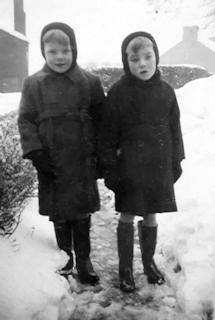
Photo by courtesy of David Walker
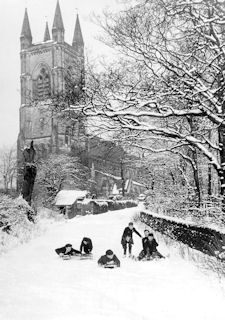
Photo by courtesy of Bryan Holdsworth
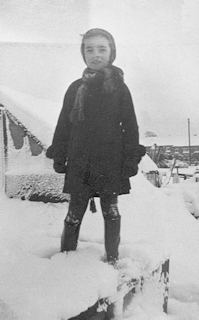
Photo by courtesy of Sandra Thorp (Eastlake)
The beginning of 1947 saw very heavy snowfalls and the snow seemed to stay on the ground forever. I was almost seven then and I remember the path that my father had cleared from the back door. The snow on either side was up to my shoulders. We built snowmen that lasted and lasted and sledged down Pinfold Lane for weeks. The picture on the right is taken from a christmas card of 1955 and shows local boys sledging down Pinfold. The boy on the tobogan at the left is Bryan Holdsworth and next to him was David Butler. I think that the boy standing up was Tony Oxley. The photo on the left is of a couple of my friends, David and Stuart Walker, outside their house in Lee Green during that winter. The middle photo is of a friend enjoying the snow at Lepton.
The photograph below was taken in front of Clough Terrace on Hopton Hall Lane during the 1946/47 winter.
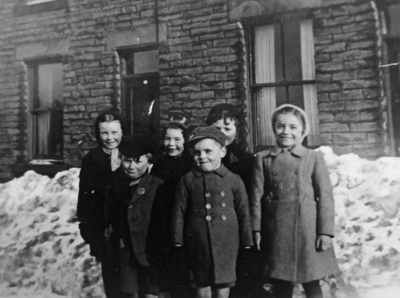
Mary Midwood, Joan Midwood, Keith Walker
Kenny Walker, Trevor Pilgrim, Sandra Eastlake
Photo by courtesy of Sandra Thorp (Eastlake)
March 1963: I was living at Dewsbury Moor then and this was our first winter as home owners. The house was a one up and one down with an outside toilet and had cost us £300.00 to buy. The temperature dropped below zero one night and stayed there for about six weeks without break. Needless to say the toilet froze solid but fortunately my in-laws lived only five minutes away so they were to be our salvation.
This house served us until 1965 when we moved back to Mirfield following the birth of my eldest son, Robert. We bought a new house in Mirfield at Towngate. It was a three bedroom end house in a block of four and cost £1875.00. It sounds good but my wage at that time was less than £15.00 per week.
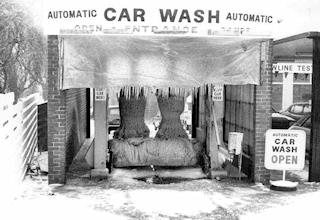
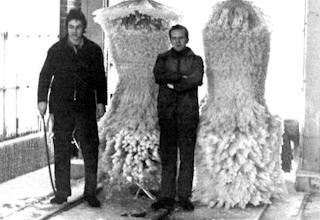
Frozen Carwash at Central Garage in 1976
1976 was another cold winter. I worked at Central Garage then and I remember that we were fighting a losing battle trying to keep the car wash operational. The photographs show the brushes frozen solid and puffed out with ice and also the icicles hanging down below the plastic screen. The bottom photo is another view of the carwash taken from inside and clearly shows the swollen brushes. The frozen workers were Neil Sherwood and Colin Beattie.
The winter scene below is taken from Hagg Wood, Lower Hopton looking toward the Parish church. The landscape and foliage is covered by a thick ground frost and a thin mist covers the whole scene.
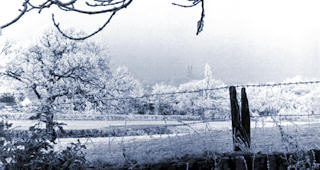
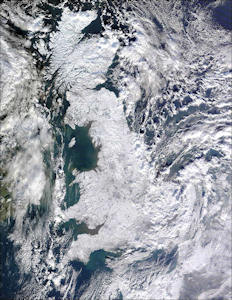
The winter of 2009/2010 was to be another one of note. November of 2009 saw the worst floods recorded in Cumbria with swollen rivers sweeping away several bridges. Cockermouth was especially badly hit and a policeman lost his life there while trying to warn others that the bridge was in imminent danger of collapse. His warnings were proved to be true when the bridge gave way before he himself could get clear and he was swept away. Months of disruption followed because of the great number of bridges that were weakened or destroyed thus severely restricting the local communities in going about their daily business due to detours of many miles being needed just to get to the other side of a river.
January 2010 began with the most severe freeze and snowfall we have experienced for many years. The snow stayed for so long and was so widespread that the local authorities had to ration the road salt and grit, and the Government took over responsibility for the supply and distribution in an attempt to make sure that supplies were maintained to all areas. The weather map on the right shows the whole country covered in a blanket of snow.
Then, just when we thought that winter had passed, heavy snow returned briefly over Ireland and Scotland at the end of March but this was fortunately short lived.
At the close of the year, December 2010 recorded the coldest temperatures since records began one hundred years ago and snow and ice remained on the ground for a long period.
Emley Moor Mast Collapses
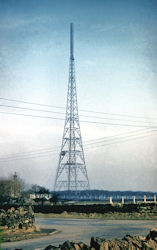
Original 1956 mast
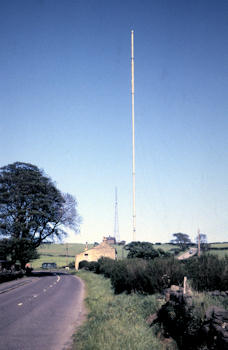
The ill fated Emley Moor mast
Emley Moor is a vital site for television transmission due to its elevated position and the current TV Mast is visible from most parts of Mirfield. The first mast went into service on 3rd November 1956 and brought television transmissions to the Yorkshire area which was a difficult area to cover due to the steep Pennine hills and the long distance to the low-lying areas of the East Riding. It was a steel structure 445 feet high similar to a very large electricity pylon. It was to serve for less than 10 years before the requirement for colour and high quality sound transmission necessitated a new mast being built in 1964. When I returned to Mirfield in 1965 this was the mast that supplied our TV pictures and the signal strength was so great that we had to have an attenuator fitted on the aerial socket because the TV was being overloaded causing ghosting of one channel behind the picture of another.
The photo shown above left is the original 'pylon style' 1956 mast while the photo above right shows both the old and the 1964 masts standing side by side. The later mast was constructed of tubular steel and rose to a height of 1,265 feet supported by steel cable guys. This design however was fraught with problems and was to instil fear in the local residents. During the cold winter weather in this exposed area, ice built up on the steel sides of the mast. When it later began to thaw large chunks of ice fell off the mast and its guys causing a hazard to life and limb for the local people and damage to buildings. The nearby Emley Methodist Church had several holes punched through its roof.
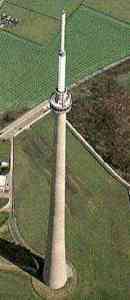
The current mast at
Emley Moor
A scheme to rehouse those living closest to the mast was being discussed in 1969 and also a canopy to protect the Methodist Church. However, before any of this could be implemented a dramatic and potentially disastrous twist of fate took a hand. Just before two minutes past five on the evening of 19th March 1969 the build up of ice on the mast increased its weight to such an extent that coupled with ice on the cable guys and high winds sweeping the exposed site, the mast buckled and collapsed destroying the building at the foot of the mast and damaging the Methodist Church so severely that it had later to be demolished. Fortunately no one was killed in the accident. The picture on the left was taken shortly after the collapse and shows the crumpled wreckage lying on the ground.
 Click the logo at the left for a first hand account by a former ITA Engineer, David Lee, who tells his
story of that fateful day in 1969.
Click the logo at the left for a first hand account by a former ITA Engineer, David Lee, who tells his
story of that fateful day in 1969.
(opens in a new window)
Not surprisingly, the local people had no wish for another mast to be erected on Emley Moor. However, this was a prime site for a television transmitter so engineers took on board the lessons learned and worked hard on a new design for the replacement. The outcome of all this deliberation was the current mast which is formed from a stronger curved tower of concrete which is now a familiar landmark in the area and has withstood the test of time.
It has a weight of 11,000 tons and is 80 feet in diameter at its base tapering to 21 feet and 3 inches at a height of 900 feet. At this level there is an observation room which is reached by a lift housed in the hollow centre of the tower. A 180 feet steel lattice mast is set on top of the tower and transmits signals to an area populated by over four million people. The total height of the mast is 1,083 feet making it the tallest self supporting television mast in the country but still 182 feet shorter than its ill fated predecessor.
